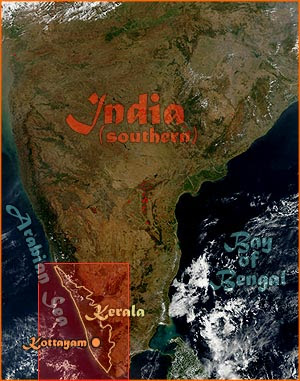Ploaie rosie din India - contaminare cu celule extraterestre?
A controversial theory, that strange red rains in India six years ago might have contained microbes from outer space, hasn’t died. In fact, things might be getting even weirder.
A new study suggests the claimed connection between scarlet rain and tiny celestial visitors may be consistent with historical accounts linking colored rain to meteor passings. These would seem to echo the India case, in which organisms are proposed to have fallen out of a breaking meteor.
“Some of these [past] accounts may have been exaggerated,” cautioned the new study’s author in reporting his findings, adding that considerable problems also dog the alien-cell proposal.
Yet the historical analysis, he concluded, shows the question is “much more complex than one might have expected” and “should be investigated with every scientific resource” available.
The study, by doctoral student Patrick McCafferty of Queen’s University Belfast, is published in the advance online edition of the International Journal of Astrobiology.
McCafferty analyzed, as he wrote, “80 accounts of red rain, another 20 references to lakes and rivers turning blood-red, and 68 examples of other phenomena such as coloured rain, black rain, milk, bricks, or honey falling from the sky.”
Sixty of these events, or 36 percent, “were linked to meteoritic or cometary activity,” he went on. But not always strongly. Sometimes, “the fall of red rain seems to have occurred after an airburst,” as from a meteor exploding in air; other times the odd rainfall “is merely recorded in the same year as a stone-fall or the appearance of a comet.”
The phenomena were recorded in times and places as varied as Classical Rome, medieval Ireland, Norman Britain and 19th century California, noted McCafferty, who has a master’s degree in archaeology and studies Irish myth and astronomy. McCafferty added that tales suggestive of red rain-meteor links also crop up in myth.
With witnesses to past events all long dead, McCafferty wrote that probably no historical analysis will ever settle the debate over the 2001 rainfalls in India.
Research claiming to connect these rains to extraterrestrial life provoked disbelief when they were first reported widely, in World Science. “I really, really don’t think they are from a meteor!” wrote Harvard University biologist Jack Szostak, referring to cell-like particles that had been reported to permeate the collected rainwater.
The curious events began on July 25, 2001, when residents of Kerala, a region in southwestern India, started seeing scarlet rain in some areas. It persisted on-and-off for some weeks, even two months. Scientists couldn’t identify the cell-like specks that gave the water its scarlet hue. Speculation of possible extraterrestrial origins began.
Two Indian scientists later published a chemical and biological analysis suggesting, they said, that the specks might indeed be little aliens. They “have much similarity with biological cells” but without DNA, wrote the researchers, Godfrey Louis and A. Santhosh Kumar of India’s Mahatma Gandhi University. “Are these cell-like particles a kind of alternate life from space?”
They cited newspaper reports that a meteor broke up in the atmosphere hours before the red rain. Louis and Kumar’s research paper appeared in the April 4, 2006 online edition of the research journal Astrophysics and Space Science. In previous, unpublished papers, the pair also claimed the particles could reproduce in extreme heat.
Some researchers, including Chandra Wickramasinghe, director of the Centre for Astrobiology at Cardiff University, U.K., have said that Louis and Kumar’s idea may well be correct. He and other supporters pointed to the consistency of the alien-cell hypothesis with the popular “panspermia” theory, which holds that meteors and comets might have seeded life throughout many planets.
But other scientists have cited problems with the theory, including a lack of clear evidence for any meteor, and the knotty question of how micro-aliens might have stayed aloft for months after bursting out of a meteor.
“Without conclusive evidence such as meteoritic dust mixed with red rain, it is difficult to say anything specific about Kerala’s red rain,” McCafferty wrote. But in history, he added, “there appears to be a strong link between some reported events [like it] and meteoritic activity. The reported airburst just before the fall of red rain in Kerala fits a familiar pattern, and cannot be dismissed so easily as an unrelated coincidence.”
www.world-science.net





Comments